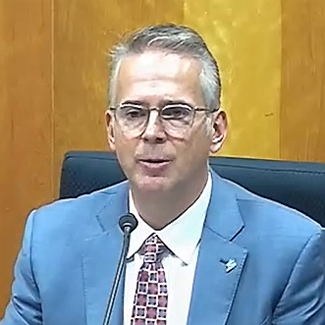Todd Hillman, currently MISO’s senior vice president and chief customer officer, is ending his nearly 20-year stretch with the grid operator and will become Sunflower Electric Power Corp.’s new CEO next year.
Sunflower’s board of directors on Nov. 21 named Hillman as its new CEO following a nationwide search. Hillman will succeed departing CEO Stuart Lowry.
Steve Epperson, CEO of Pioneer Electric Cooperative and Southern Pioneer Electric Co., two of Sunflower’s seven distribution member-owners, said Hillman is a “best fit” for Sunflower.
“I see great teamwork, collaboration and courageous decisions in our future and am confident that Mr. Hillman will deliver,” Epperson said in a press release.
At MISO, Hillman was responsible for customer relations, including member and regulatory relationships, and managing training, facilities and the RTO’s call center.
Hillman said it will be “bittersweet” leaving the organization. He joined MISO in 2004 as it prepared to launch its energy markets in April 2005.
“Imagine 100 employees, give or take. It was all-hands-on deck,” Hillman said in an interview with RTO Insider. “I just remember so much happening, and it was going so fast, and everyone was working on everything.”
MISO currently has about 950 employees.
Hillman said his first title with the grid operator was the generic “executive director.”
“We weren’t quite sure what the role meant yet,” he said.
Hillman joined the RTO after a stint at Reliant Energy’s offices in the Netherlands, where he managed various electricity, natural gas and transmission contracts. While there, he also established a European satellite office in Frankfurt, Germany. After Reliant’s sale of its Dutch operations, he returned stateside for Reliant before landing at MISO’s Carmel, Ind., headquarters.
“So naturally after working in Europe, Carmel, Indiana, is the next logical step,” he said.
“Todd’s contributions to MISO have been unbelievable,” MISO CEO John Bear said during an executive update Monday. He thanked Hillman for his dedication in integrating the MISO South region.
Hillman said MISO’s successful integration of Entergy as MISO South in 2013 ranks among its greatest achievements during his tenure. He described the work as “climbing Mt. Everest with one hand tied behind your back.”
“It took a village to do that,” he reflected.
Hillman said he considers the grid operator’s employee culture as his greatest personal accomplishment. He said he’s proud of the strides made on workplace diversity, equity and inclusion. He pointed to the creation of dedicated resource groups for employees who are also caregivers or veterans and employees’ annual $1 million in contributions to the Make-A-Wish Foundation.
“I look back, and I think about the culture,” Hillman said.
He said MISO today allows its employees to be creative and thrive in an industry that “isn’t smooth sailing.”
Hillman said MISO’s endeavor to attract and retain talent must continue. However, he said MISO is making progress and voiced confidence in Allegra Nottage, the RTO’s first chief diversity officer. (See MISO Installs First Diversity Officer; “High employee turnover concerns leadership,” MISO Board Week Briefs: Sept. 12-15, 2022.)
Hillman said MISO has a “huge opportunity to reset the turmoil” wrought by the Covid-19 pandemic and the Great Resignation.
“I feel like it’s a work in progress, but I know I leave it in great hands,” he said.
Hillman remembered challenging times during MISO’s early days, when Ohio and Kentucky members departed the footprint as former CEO James Torgerson also announced his exit in 2008.
“Imagine you’re having all this turmoil against a senior leadership change,” Hillman said.
Hillman said in all, MISO lost 7% to 10% of the footprint but gained roughly 30% in service territory with a spate of new memberships that began with MidAmerican Energy’s entry in 2009.
“So, we lost members, but then we had more members come on [within] a few years,” he said.
Hillman also said he has thought about his impending transition from MISO to SPP, where Kansas-based Sunflower is a member. The two RTOs attempted to merge last decade and remained rivals until recently.
“I promise I’m going to be a very good stakeholder,” he said. “I know how tough it is, so I want to be a help.”
Hillman said he’s encouraged by the RTOs’ collaboration in recent years and said he will place his Sunflower hat on and will advocate for his utility. “As it gets tougher in the business, the more those relationships can improve,” he said.
Hillman said he’s taking three important lessons learned from his time at MISO to Kansas.
“You always assume noble intent with anyone you’re working with,” he said. “Very few times are there issues that are black and white, and you can’t get the ball across the line. We have to figure out how to get that [assumption of] noble intent on both sides up across the industry.”
He said he plans on listening to all sides of an issue, something that’s served him well working with MISO’s 11 sectors and their differing viewpoints. He also said he will always remember that people are responsible for the electric industry’s operations and progress.
“This is very complex work at the end of the day. And I always remember that there are people behind it,” Hillman said.
He said he’s excited about Sunflower’s “main street” element and meeting customers. Hillman joked that he’s equally excited to “serve just one state,” instead of the 15 in MISO’s footprint.
Hillman said he’s “learned from the best” from MISO and its members and said he’s taking those leadership templates with him to Sunflower.
“People ask me, ‘Are you ready to be CEO?’ I don’t know, but I feel incredibly confident that if I can be anywhere near what they have done, I’ll be all right.”
